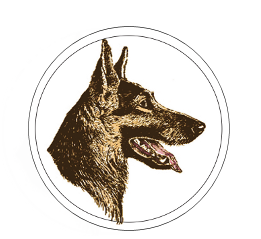THE DOG’S NOSE KNOWS YOU KNOW
John Cox
The most amazing thing about a dog is not that it’s brain appears to be about the size of a peanut but that their noses, or perhaps more accurately, their Olfactory Mucous Membranes seem to be about the size of a coconut! During the evolutionary process, those creatures whose environmental circumstances have called for a greater need for a keen sense of smell in order to survive, have developed their scenting powers most. The Canis family have honed this sense to a very fine degree. In man, only a small area in the upper part of the nose is covered by the olfactory mucous membrane. In our best friend, this tract is much greater, see above. The size of the sensitive area has nothing to do with the size of the animal as man and many other creatures, bigger than a dog, have smaller olfactory mucous membranes.
THE DOG’S KNOWS YOU KNOW
(PART 2)
Scent is a subject about which one could waffle for days. In fact, I am going to make a particular effort here to keep things as basic as possible in order to avoid controversy. What is scent? It is an odour or a smell. We all Know this but, when talking about a scent, what is the key factor, what is the common denominator? Moisture. Without moisture there is no scent. To a greater or lesser degree, moisture is everywhere. It in wood, leather, grass, flesh, and even in the air we breathe. Every atom has in it’s composition, a quantity of water. Scent is retained in moisture and its strength and durability is determined by the time it takes for the moisture base to evaporate. Even we, as humans, can smell a wet dog more easily than a dry one or a newly painted room, only plucked flower and so on. As it dried out, everything becomes more difficult to smell. For practical purposed, scent can be divided into two board categories. Ground scent and Wind scent. The ground scent, which is followed by the dog tracking, is caused by contact with the ground, resulting in disturbance. The slightest movement of the soil or the crushing of the grass, other vegetation and insect life, leaves particles and or drops of moisture lying on the ground. All give off a scent and thus denote a trail. For example, Most and Bruckner, in the early part of the century, arranged to have the trail of a man vanish into thin air, halfway across a flied. They did this by making the man walk over soft earth and at a certain point carried him away with a trolly attached to an overhead cable. The trail was continued onwards by a large wheel with shoes fixed at one pace intervals around the rim. The dog was set to follow the trail and continued past the changeover point apparently without noticing the difference. The experiments concluded that the animal followed the track by virtue of the smell of newly disturbed earth and crushed/bruised vegetation. Some of this scent may adhere to the crushing instrument, the footwear for example and be carried some distance from one type of ground to another. This is very important where there are sudden changes in ground surface such as grass to tar, and this does, in fact, assist the dog greatly. It becomes clear at a glance why our scent signature is so distinctive. One need hardly elaborate on the fact that Human Scent varies depending on diet and circumstances. A garlic-noshing frightened criminal on the run, will hardly smell the same as a chemist who has just finished a shift in her laboratory. Even I can tell the difference between the smell of an average male and female as far as the regional scent is concerned, I need no convincing that my hands and feet do not usually, thank goodness, smell the same. Type and age of footwear, shoe polish, occupation and clothing all play an additional and sometimes important part in the scent signature. The crushing of the ground surface, vegetation and insects help to complete the picture. All scent containing moisture, is subject to the effects of evaporation and is therefore influenced climatic conditions. Many people mistakenly believe that a six-hour old track is harder for a dog to follow than a one-hour old track. However, whilst time is important, ground surface, heat, humidity, wind and a host of other factors can have the effect of preserving or destroying scent. If a trail is laid through long lush damp grass during the early evening in winter, a track could be much easier to follow twelve hours later than a half hour old track, laid at noon, in summer on a stoney, surface, sparsely grassed. Heat is our main enemy as it is this that causes heat. The strength of the from the sun varies and these variations after the effect of the scent. At noon in hot climates during summer, the heat is intense, and the evaporation rate is rapid. Scent retention is therefore minimal. At midday in polar regions, the sun sheds light, sometimes for twenty-four hours per day but there is little heat and scent endures for long periods. Rescue dogs in such regions as Newfoundland, can follow trails and detect man after many weeks. Wind is of course another enemy and it can dissipate scent where grass is not long, and smell is not trapped at the base of a corridor. However, when searching for people and articles recently hidden, the wind can assist us greatly if we work the dog from the downwind position.
